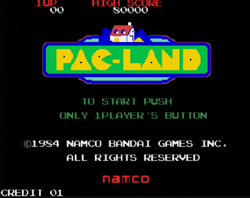 This article is going to require a little background.
This article is going to require a little background.
In 1980, Pac-Man was released. By 1984, Pac-Man had spread as Pac-Fever, and the whole of the world (or at least the part of the world that had quarters) was obsessed with the little yellow dude (and his wife, if we are legally allowed to mention her this week). So, for the first time in four years, Pac-Man decided to branch out. After multiple Pac titles that attempted to capitalize on the familiar Pac-Man gameplay (and a seemingly infinite number of “maze likes” that copied Pac-Man’s gameplay wholesale), Pac-Land sauntered onto the scene to try something different. No more would Pac-Man wander around nondescript mazes in an attempt to gobble up dots. No! This puck-man had legs! And a hat! And he was venturing far from home to return a lost fairy to Fairyland (as you do), and gaining flying boots (good thing he has feet now!) for his troubles. No more was Pac-Man obsessed with endless consumption, and the “four” ghosts that had plagued him in the past were now an army with planes, chains, and automobiles. About the only thing here that was 100% pac-gameplay was the beloved power pellet, and even that wound up being more of an “end of the level” bonus than the nigh-always accessible “spinach” of previous pac-titles. Pac-Land was and continues to be a whole new dimension for Pac-Man.
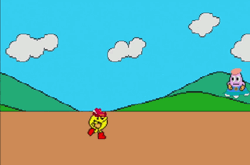 But it was not simply Pac-Man that was revolutionized by Pac-Land. Pac-Land, right there in 1984, practically invented the concept of the endless runner. Where once ol’ Pac-Man could only be credited for normalizing the maze-based gameplay that was the focus of his early adventures, Pac-Land created something that would come to define “mobile titles” for a generation of hardware. The arcade cabinet for Pac-Land had no joystick: there was a jump button, and directional run buttons. You cannot “steer” Pac-Man, you simply control how fast he is going (by repeatedly tapping the run button to go faster), and when Pac-Man jumps. And that’s it! There is little backtracking, there is no permanently turning from danger: there is simply running. Endless running. Once every few stages, you gain an infinite jump, but that is the only real “change” that ever occurs in Pac-Land. This is an endless runner with extremely simple gameplay, and, considering it was released in 1984, it was eerily prescient on a possible future for gaming that would come two decades later.
But it was not simply Pac-Man that was revolutionized by Pac-Land. Pac-Land, right there in 1984, practically invented the concept of the endless runner. Where once ol’ Pac-Man could only be credited for normalizing the maze-based gameplay that was the focus of his early adventures, Pac-Land created something that would come to define “mobile titles” for a generation of hardware. The arcade cabinet for Pac-Land had no joystick: there was a jump button, and directional run buttons. You cannot “steer” Pac-Man, you simply control how fast he is going (by repeatedly tapping the run button to go faster), and when Pac-Man jumps. And that’s it! There is little backtracking, there is no permanently turning from danger: there is simply running. Endless running. Once every few stages, you gain an infinite jump, but that is the only real “change” that ever occurs in Pac-Land. This is an endless runner with extremely simple gameplay, and, considering it was released in 1984, it was eerily prescient on a possible future for gaming that would come two decades later.
But creating a genre was not enough for Pac-Land to leave an indelible mark on gaming forever. Shigeru Miyamoto reportedly stated that Pac-Land was an influence on Nintendo games going forward. Do a little research, and you’ll find that Miyamoto was very specific about what Pac-Land influenced. For at least one legendary games designer, Pac-Land was all about this…
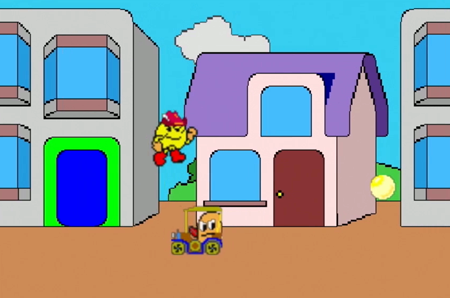
Or… to be clear…
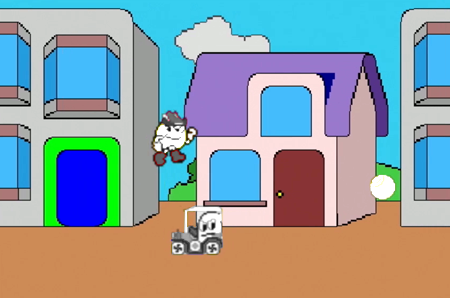
The big thing that influenced Shigeru Miyamoto? The sky of Pac’s Land is blue. In a 1998 interview, Shigeru Miyamoto admitted that he saw Pac-Land as stiff competition for his already successful (but undoubtedly waning) Donkey Kong. And he had a 2-D side scroller already in mind for Jump Man, but Pac-Land had something he had not considered: a world.
Right from the initial release, Pac-Land’s blue skies separated it from the land. When Pac-Land was transported overseas to America, it gained additional details that tied it to the (then new) Pac-Man animated series. But, regardless of version, Pac-Land always had a clear sense of geography and space. Pac-Man starts at his home. Pac-Man ventures through a town, whether that be a pristine village with houses and fire hydrants, or a jumbled mass of seaside walls and water. There is a forest. There is a mountainside. It genuinely feels like there is a lot of land for Pac-Man to cover on his way to Fairyland. And Fairyland looks completely separate from Pac-Man’s world! And then, immediately after visiting this magical grove, Pac-Man ventures back over familiar territory, but with a new, unstoppable super power. The world is the same, Pac-Man is changed, and a simple narrative begins to take shape. And it all traces back to something as simple as the sky being blue.
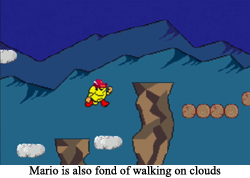 And let’s not underestimate how a “blue sky” led to the success of Super Mario Bros. SMB has amazing gameplay, memorable characters, and a “loop” that lends itself perfectly to gaming in 1985. But that blue sky is what keeps you going. Mario’s first adventure was in a nondescript construction site that could be easily mistaken for a pie factory. Mario’s second journey was through a sewer that was identified by prominent pipes. But Super Mario Bros.? That is an adventure through a world. Mario is saving the Mushroom Kingdom, and everything from bricks to castles to deep oceans tell the player that Mario is making progress through this land. This is a place, this is a country, and it has been conquered by an invading force of turtles and chestnuts. You will venture through every underground area, every cloud-filled sky, to save this place. We’re sorry, Mario, but our princess is in another castle, and that means you are going to the next, separate castle. So there are more castles, Toad?! Aren’t we excited to see more of this world?
And let’s not underestimate how a “blue sky” led to the success of Super Mario Bros. SMB has amazing gameplay, memorable characters, and a “loop” that lends itself perfectly to gaming in 1985. But that blue sky is what keeps you going. Mario’s first adventure was in a nondescript construction site that could be easily mistaken for a pie factory. Mario’s second journey was through a sewer that was identified by prominent pipes. But Super Mario Bros.? That is an adventure through a world. Mario is saving the Mushroom Kingdom, and everything from bricks to castles to deep oceans tell the player that Mario is making progress through this land. This is a place, this is a country, and it has been conquered by an invading force of turtles and chestnuts. You will venture through every underground area, every cloud-filled sky, to save this place. We’re sorry, Mario, but our princess is in another castle, and that means you are going to the next, separate castle. So there are more castles, Toad?! Aren’t we excited to see more of this world?
Over time, backgrounds became standard in games that did not ever need a sense of place. The whole of the fighting game genre is replete with titles that made the choice between “they are fighting in a large, grassy field” or “they are fighting specifically in front of a busy Chinese street where some dude is selling caged chickens”. While the distinction is not universal, it seems the games that made the latter choice are more likely to be successes. Similarly, JRPGs have come to be defined by their worlds, with “generic dungeons” always paling in comparison to skulking through volcanos, sky fortresses, or ice caverns. Could the likes of Cloud or 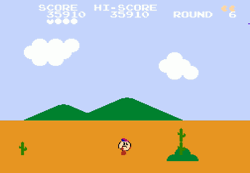 The Luminary be content with caves that have nothing more to them than black backgrounds and an assortment of monsters? Theoretically yes, but wouldn’t you rather venture through a dilapidated train yard? The tiniest bit of background adds… background to the proceedings, and that can make all the difference in a narrative that is meant to drive the player and disguise how so many games are simply about making numbers go up.
The Luminary be content with caves that have nothing more to them than black backgrounds and an assortment of monsters? Theoretically yes, but wouldn’t you rather venture through a dilapidated train yard? The tiniest bit of background adds… background to the proceedings, and that can make all the difference in a narrative that is meant to drive the player and disguise how so many games are simply about making numbers go up.
So, like Shigeru Miyamoto, let us thank the inspirational Pac-Land. With the simple addition of backgrounds, Pac-Man was given a world. And from that world, whole universes have formed.
FGC #632 Pac-Land
- System: I am not comfortable with all the ways you can play Pac-Land. There was the NES port. The Commodore 64 or Atari ST ports. The TurboGrafx-16 port. It had a Lynx port. And then it wound up on the Playstation, Xbox 360, and Playstation 3 as parts of various collections. It was available ala carte on the WiiU. And now it is available on all modern systems thanks to yet another Pac-collection. It… wasn’t on the Super Nintendo, I guess.
- Number of players: Technically two, put it is alternating.
- Port-o-Call: Depending on your version or region, you may find a lot of differences between the various Pac-Lands. Does the “rest stop” church have a cross? Is the music playing the same ditty from the Pac-Man animated series? Have Ms. Pac-Man and Baby Pac-Man been replaced by the nefarious imposters, Pac-Mom and Pac-Sis? Don’t for a moment imagine that time and copyright law have not impacted the gentle denizens of Pac-Land.
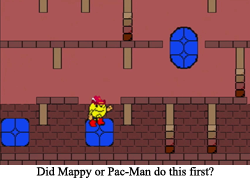 Favorite Level: Anything that does not involve the “broken” ground of the water stages is my favorite. I guess the mountain stages win, then? I like the idea that Pac-Man is going on a happy little hike, and the ghosts just happen to be an omnipresent threat that haunts Pac’s life because of all those crimes he did in the 60’s.
Favorite Level: Anything that does not involve the “broken” ground of the water stages is my favorite. I guess the mountain stages win, then? I like the idea that Pac-Man is going on a happy little hike, and the ghosts just happen to be an omnipresent threat that haunts Pac’s life because of all those crimes he did in the 60’s.- For the Sequel: The obvious, direct sequel to Pac-Land is Pac-Man 2: The New Adventures. That was another attempt to invent an entirely new genre of pac-gameplay, and… well… Cell phones or not, the whole “marginally control a cartoon character” thing never really caught on. More’s the pity, as Pac-Man 2 is definitely the more revolutionary title, if only because making Pac-Man mad at cows is a gameplay echelon The Last of Us could only ever hope to achieve.
- Did you know? A lot of Pac-Man’s move set in Smash Bros. is partially or wholly based on actions/obstacles found in Pac-Land. So if you are wondering where he got that jump, MS Paint scrolling background, or the fire hydrant, look no further than Pac-Land. Or don’t, because literally every other Pac-Man game is probably a better choice.
- Would I play again: This is yet another important title in gaming history that I do not need to play ever again. And I won’t miss it, either! Ms. Pac-Man is right there! Assuming I’m legally allowed to play it this week!
What’s next? Random ROB has chosen… Sonic CD! It’s like regular Sonic the Hedgehog, but with all the power of CD technology! Wow! Please look forward to it!
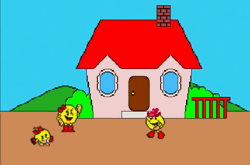
Happier times…